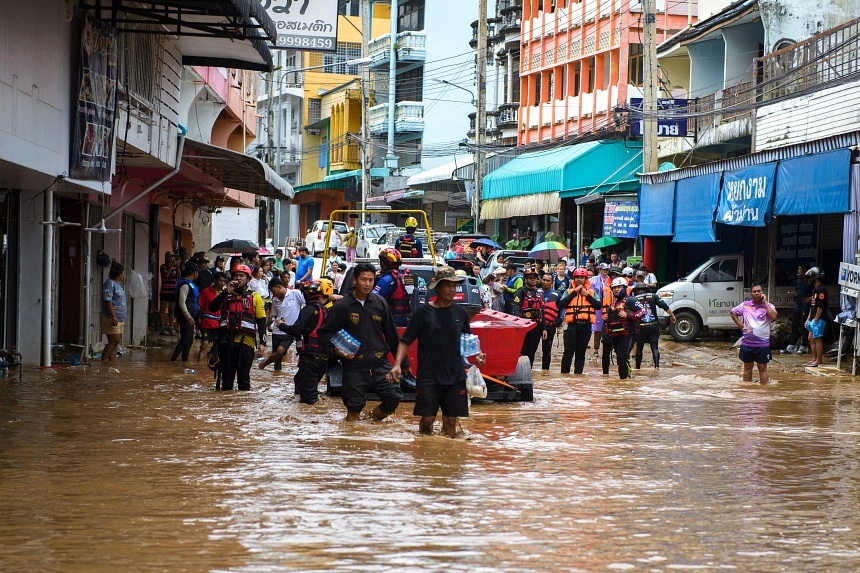HANOI - Millions of people across South-east Asia struggled on Sept 12 with flooded homes, power cuts and wrecked infrastructure after Typhoon Yagi swept through the region, as the death toll surpassed 200.
In worst-hit Vietnam, the fatalities rose to 197, while nine people were confirmed dead in northern Thailand, where one district is experiencing its worst floods in 80 years.
Myanmar’s national fire service confirmed the country’s first Yagi-related deaths after 17 bodies were recovered from flooded villages in the Mandalay region, while more than 50,000 people have been forced from their homes.
Yagi brought a colossal deluge of rain that has inundated a swathe of northern Vietnam, Laos, Thailand and Myanmar, triggering deadly landslides and widespread river flooding.
One farmer on the edge of Hanoi told Agence France-Presse that his entire 1,800 sq m peach blossom plantation was submerged, destroying all 400 of his trees.
“It will be so hard for me to recover from this loss – I think I will lose up to US$40,000 (S$52,000) this season,” said the farmer, who gave his name only as Tu.
“I really don’t know what to do now, I’m just waiting for the water to recede.”
The United Nations Children’s Fund said the typhoon had damaged more than 140,000 homes across 26 provinces in Vietnam.
Communications cut off
The high waters have devastated more than 250,000ha of crops and huge numbers of livestock, Vietnam’s Agriculture Ministry said, with farmland around Hanoi hit hard.
Commuters in parts of the Vietnamese capital trudged to work through shin-deep brown flood waters, though officials said river levels in the city are slowly falling after hitting a 20-year high on Sept 11.
Thousands have been forced to evacuate their homes, while others are struggling with power cuts.
In the deadliest single incident, a landslide in Lao Cai province annihilated an entire village of 37 houses, killing at least 42 people and leaving 53 still unaccounted for.
Rescue teams pulled victims from the mud on Sept 12, carrying them on stretchers to makeshift shelters, where neighbours and relatives carefully washed the bodies to prepare them for burial.
Survivors picked through the mud and wreckage to retrieve any family heirlooms or possessions they could find.
Fifteen bodies have been recovered in Cao Bang province after a landslide on Sept 9 pushed a bus, along with several cars and motorbikes, into a stream, the state media said on Sept 12.
Myanmar camps
Myanmar’s junta government has set up around 50 camps, anticipating that around 70,000 people could be affected by the floods, said Ms Lay Shwe Zin Oo, director of the Social Welfare, Relief and Resettlement Ministry.
No casualty numbers or details have been given, but flooding in Myanmar is most severe around the junta’s sprawling, low-lying capital Naypyitaw.
The Global New Light of Myanmar, the state-run newspaper, said train services on the main line between Yangon and Mandalay were suspended because some sections were flooded.
The Mekong River Commission, the international body overseeing the crucial waterway, issued a flood warning on Sept 12 for the historic Laotian city of Luang Prabang.
The Mekong is expected to hit flood levels on Sept 12 in Luang Prabang, a Unesco World Heritage Site, the commission said in a bulletin.
In Thailand, the death toll has risen to nine, the Department of Disaster Prevention and Mitigation said, including six killed in landslides in Chiang Mai province.
All flights have been suspended to the airport in Chiang Rai, some 145km north-east of Chiang Mai, the aviation authorities said.
Further north, Mae Sai district on the border with Myanmar is suffering its worst floods in 80 years, Interior Ministry senior official Suttipong Juljarern said in a statement.
The Jet Ski Association of Thailand has sent 16 jet skis to help with relief efforts, the body’s president Dechnarong Suticharnbancha told AFP.
Some of the currents in the flood waters are too strong for normal boats, but jet skis are able to navigate them because of their powerful engines.
A video showing champion jet skier Kasidit Teeraprateep rescuing an old woman from a torrent of murky water circulated on Thai social media.
While the military is sending boats, helicopters and other transport to help relief efforts, Buddhist temples, along with hotels and resorts, have opened their doors to accommodate almost 1,000 people flooded out of their homes.
Heavy monsoon rains lash South-east Asia every year, but human-caused climate change is causing more intense weather patterns that can make destructive floods more likely.
Climate change is causing typhoons to form closer to the coast, intensify faster and stay longer over land, according to a study published in July. AFP

